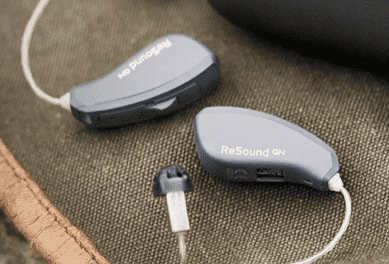By Karen Spaeth, Starkey
Hearing aid technology has transitioned from a single-purpose device designed to treat a single condition, hearing loss, to a multi-purpose device designed to monitor and track other important health indicators related to hearing loss. Not only are hearing aids capable of connecting directly to smartphones, but now, through the use of embedded sensors, machine learning, and artificial intelligence, hearing aids are themselves getting smarter and adding value that goes well beyond amplifying sound.
Related article: Starkey Introduces Livio Edge AI
The ear is a gateway to understanding someone’s health and wellness and is a highly effective place to measure key health indicators. Livio Edge AI, for example, uses AI and integrated sensors to detect physical movement, social engagement, and even falls. When paired with the Thrive Hearing Control app, the hearing aids deliver a “Body Score,” which tracks daily steps, movement, and exercise, as well as a “Brain Score,” which measures hearing aid usage, social engagement, and the variety of acoustic environments encountered each day. Additionally, the new Thrive Care app allows hearing aid users to grant permission to family members, friends, or professional caregivers to monitor their physical activity, social engagement, and fall activity in real time.
“By designing hearing aids with a focus on impacting overall health and wellness, we are able to help address the many conditions and comorbidities that are associated with hearing loss,” said Starkey Chief Health Officer Archelle Georgiou, MD. “For example, we know that there is a strong correlation between hearing loss and dementia, depression, and even cardiovascular disease. By monitoring fitness and social engagement, the AI technology in hearing aids gives people an opportunity to understand how to alter their lifestyle to decrease their risk, hear better, and, ultimately, live better.”

Starkey accelerated the innovative use of AI during COVID-19. The communication challenges for individuals with hearing loss are compounded by the use of face masks, loss of lipreading cues, social distancing, and sound distortion that occurs during video conferences. To address this, Starkey launched Livio Edge AI hearing aids with Edge Mode technology.
“It’s a perfect opportunity for us to bring in machine learning and artificial intelligence as a solution for those challenges,” said Starkey Chief Innovation Officer Dave Fabry, PhD. “By using AI-based acoustic analysis and processing, Edge Mode instantaneously optimizes speech audibility to offset communication challenges presented by face masks, social distancing, and background noise. Hearing aid users have reported that this feature has enabled them to stay connected during the COVID-19 pandemic.”
In the near future, there are exciting developments underway to further use artificial intelligence to address speech and noise problems, which continue to be significant for most hearing aid users.
“For the first time, we’re starting to comingle the processing power of hearing aids and smartphones and using deep neural network AI to continue to expand the value of hearing aids, ” said Fabry. “This can increasingly provide opportunities for sound quality and speech intelligibility in noise. I think we’re going to see major trends with that combination and coordination between the hearing aid as a standalone device and the smartphone.”
“There are so many reasons to be optimistic about the future of hearing healthcare and what that means for our overall health and wellness,” said Georgiou. “Perhaps a small silver lining with COVID-19 is that individuals with mild hearing loss have realized they can no longer ignore their impairment and are taking steps to address it.”
Source: Starkey





